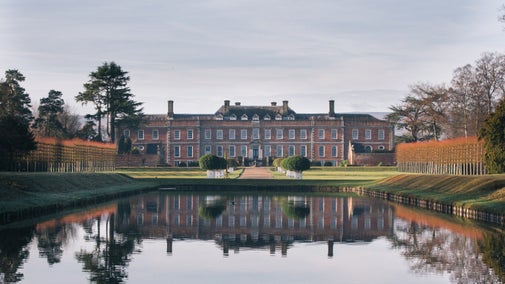
Discover more at Erddig
Find out when Erddig is open, how to get here, the things to see and do and more.

Visit a fully restored 18th-century garden at Erddig, shaped by the plans of John Meller. A rich London lawyer, Meller bought Erddig in 1714, and today you can see fruit trees in abundance, just as they featured in Joshua Edisbury’s original garden plans in the 1680s. Discover a wide variety of fruit trees in this Grade I-listed garden, planted during the restoration.
Enjoy nature's greatest show in Erddig’s 13.5-acre walled garden as waves of spring highlights wash over the garden.
First to arrive are snowdrops found in clusters on the west front of the hall and along Moss Walk in the walled garden. There’s hundreds growing in the tea garden, so why not grab something warm to go from the restaurant and enjoy these delicate white beauties?
Next to follow are daffodils, the Welsh emblem of St David’s Day. Their dazzling blaze of yellow nodding flowers transform the banks of the garden’s canal and brighten any spring stroll around the garden.
Look out for the late-flowering fragrant pheasant’s eye variety, Narcissus poeticus, with its elegant white petals and an orange-rimmed cup. Discover them growing between the apple trees and conical topiary in the orchards.
As spring finally crescendos into summer, wild orchids bloom in the meadows along the banks of the canal.
Each year we wait in anticipation of blossom season. At Erddig we're treated to delicate magnolia, cherry, pear and apple blossom throughout the garden, orchards and espaliered along the garden walls.
The first blossom to expect is the cherry blossom in early March, which can be found near the entrance to the garden and next to the fishpond. Its pink petals looks stunning reflecting on the water. This is closely followed by plum blossom in mid to late March. Look for it in trained fans throughout the borders. Expect to see pear blossom in early April, with apple blossom making an appearance at the end of April. The blossom season usually ends late May, depending on the weather.

Throughout the year, loose gravelled pathways around the walled garden allow visitors to easily enjoy the views without getting too muddy or wet, and little feet enjoy the crunching sound come rain or shine.
Erddig features extensive lawns, trained fruit trees, exuberant annual herbaceous borders, avenues of pleached limes, formal hedges, conical topiary, a nationally important collection of ivies and a Victorian parterre bedding display that usually changes twice a year.
The double avenues of pleached lime trees are a remarkable feature here at Erddig. The trees form a ‘living wall’ and mark the position of the original walled border of the Grade I listed garden, which was later demolished.
They burst into bud around April time, a sure sign that warmer days are here.
The extensive pleached lime tree avenues are pruned by hand. This ancient art, which dates from Roman times, involves connecting branches together to create a shaded walkway to promenade.
It would take one skilled gardener around 10 weeks (about 2 and a half months) to complete the task single-handedly, making around 65,000 cuts – thankfully we have a small team on hand to take on the mammoth challenge!
The Victorian parterre can be found at the rear of the house. It is thought to have been originally laid out around 1861, but was overgrown when the property came into the care of National Trust Wales in the 1970s. Using old photographs and archaeological evidence, the Trust reinstated this area to what visitors see today.
The planting scheme changes with the seasons. Expect to see it bursting with colourful tulips in spring and pansies in winter.
The central canal was created in the 18th Century and is surrounded by wildflowers and double avenues of lime trees which are thought to have been planted around 1800.
In the spring, the canal bank is bursting with wildflowers, daffodils, crocuses and primroses and as spring turns to summer pink common spotted orchids, which are recorded by the garden team.
Close by is the fishpond, which in the 18th Century provided food for those living in the house. Look out for the beautiful pink cherry blossom in spring, water lilies from late spring through summer and the acer, which is particularly stunning in autumn.
You can expect to find lots of wildlife living here, including swans, Canadian Geese, coots and carp.
At the end of the canal sit the wrought iron gates, which were brought from Stansty Park in the early 1900s. Attributed to Robert Davies, they were installed in their current position in the 1970s when the property came into the Trust's care.
This walled garden is a beautiful, secluded spot with gates onto the garden, parterre and westfront. Its curved beds contain herbaceous plants and bulbs, roses such as rosa centifolia, trees and climbing roses. Around April look out for the clematis montana ‘Grandiflora’.
Take a seat on one of the benches, relax with a book and soak up the wonderful scents around you.

An impressive feature of the garden at Erddig are the Irish yew trees, which were planted in around 1865. They form a lovely avenue walk to the Victorian garden where you’ll find roses, clematis and planters filled with seasonal colour.
In the summer months look out for the soft pink rosa spectabilis which is grown using a catenary, a curved rope which encourages the rose to hang between two points. The roses are pruned in winter, with the gardeners reserving two stems on each side to train on the ropes to create this curved effect.
Visitors to the West Front of the property will notice the 'Boston Creeper' Ivy - Parthenocissus tricuspidata, which transforms from green in late spring into a stunning scarlet and deep crimson in autumn.
Philip Yorke I commissioned Williams Emes to landscape this part of the estate between 1767-89. It included work on the meadows, tree planting and the building of the Cup and Saucer, which you can visit during a walk on the estate.
Look out for a sapling planted by King Charles II in December 2022 as part of our Green Canopy. His Majesty and then First Minister Mark Drakeford planted a rare sapling which had been successfully grafted from the historic Pontfadog Oak, which fell in a storm in 2013.
The ancient Pontfadog Oak, stood at Cilcochwyn Farm, near Chirk, Wrexham, and was cared for by generations of the Williams family. It was thought to be one of the world’s largest and oldest oak trees.
In 2013, The Crown Estate propagated the original Pontfadog Oak tree and planted a tree in Windsor Great Park. A further five Pontfadog Oaks were then grafted from this tree; three have been gifted to National Trust Cymru, and two are cared for by the National Botanic Garden of Wales.
The sapling was planted in memoriam to honour Her Late Majesty Queen Elizabeth II.
Discover the secrets of Erddig on one of our free tours led by expert volunteer guides.
Tours last approximately 30 minutes and look more closely at a variety of topics, for example our most popular Potted History tour, which provides a general introduction to Erddig, and the History of the Garden Tour, Working Estate tour, and Vehicles tour.
Outdoor tours are run between March to October and weekends only in November. Dates will depend on volunteer availability, please check with the ticket office on the day of your visit to find out if one is taking place. There is no booking required - simply visit the Midden Yard where you'll find the day's tour times and meeting point.

Dotted along the pathways you’ll find seats and alcoves to sit and rest awhile. Be sure to find the two hidden alcoves to the north and south of the Victorian parterre, perfect for a picnic.
In summertime and on dry days in spring and autumn, the deckchairs are out, and you can relax for as long as you like or bring your own picnic blanket.
Enjoy a family walk or tick off several of the '50 things to do before you’re 11¾' activities in the garden. You can easily do No. 8 Spot a fish or No. 31 Make friends with a bug and the garden is perfect for No. 1 – Get to know a tree.
We’re sorry, but dogs are not allowed in the Grade I-listed garden, but they are welcome on the 1,200-acre estate and in the tea garden through to the Midden Yard.


Find out when Erddig is open, how to get here, the things to see and do and more.

Discover the top things to see and do when you visit the parkland. From meandering rivers and an 18th-century water feature to the dramatic escarpment leading to Wat’s Dyke.

Check out the places to eat and shop at Erddig. Most are set within historic outbuildings and every purchase helps us to look after Erddig for future generations to enjoy.

Find out about the High Sheriff who lived beyond his means when he built Erddig, the rich London lawyer who extended and redecorated it and 240 years of the Yorke family.